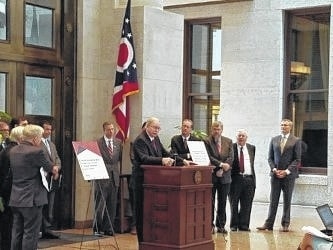
COLUMBUS — Mayor Mike Barhorst joined other Ohio municipal officials for a press conference held recently to announce the release of “A Strategic Framework & Action Agenda” for Ohio’s municipalities at the Statehouse Atrium in Columbus.
The document details a number of specific policies that are essential for revitalizing Ohio’s cities and villages, the steps necessary to strengthen the partnership between the state and municipalities, and the fact that municipalities are the state’s primary engine of economic growth.
The report was created in consultation with Dr. R. Gregory Browning, who served as Ohio’s budget director under Governor George Voinovich. Browning is now president of Capital Partners, a firm whose primary focus is policy, strategy and leadership advisory services.
“Due to a confluence of forces, municipalities have been forced to delay infrastructure maintenance, repairs and improvements,” Browning said, during the press conference. “Municipalities have been forced to replace full-time employees with part-time employees, outsource work, make lower investments in public health, safety and drug fighting efforts, reduce investment in economic development, and increase municipal taxes and fees.”
“The negative outcomes associated with the state’s municipal disinvestment are not limited to municipal finances and operations,” Browning said. “Rather they connect directly and profoundly to economic growth opportunities related to municipalities and their regional economies — economies that produce nearly 90 percent of Ohio’s gross state product. This means that stable, effective municipalities and a revitalized state municipal partnership are essential ingredients in Ohio’s economic competitiveness.”
The report specifically proposes that during the 2017-2018 legislative session, the General Assembly:
1) Phase-in a restoration of the Local Government Fund to strengthen municipalities and their regional economic competitiveness;
2) Increase the state motor vehicle sales tax to address the growing backlog and growing need for new state and local transportation infrastructure projects;
3) Develop a state/local infrastructure study commission to propose a right-sized state bond issue for non-transportation infrastructure, including billions of dollars for identified clean water and wastewater projects;
4) Guard against new unfunded state mandates and home rule erosions and seek more flexibility for municipalities to raise additional local revenues;
5) Resolve Medicaid related health insuring corporation sales tax termination for state (-$550 million per year) and local (-$200 million per year) governments without cuts to local government; and,
6) Address the state’s opioid epidemic effectively by providing assistance to municipalities, which are on the front lines of addressing this costly crisis and create a state drug addiction task force and an Ohio Public Safety Action Fund to help finance policy and program level solutions.
Barhorst spoke specifically about infrastructure funding.
“Infrastructure has been a much discussed buzzword locally, statewide and nationally for some years,” Barhorst said. “Most of us will remember President Obama standing beneath the Brent Spence Bridge in September of 2011 discussing the need for Congress to appropriate $50 billion for immediate infrastructure needs. Near the date the president spoke, a large concrete section of the bridge fell off and smashed the vehicles parked beneath the bridge — a bridge that was long before labeled functionally obsolete by the United States Department of Transportation.”
“Now five years later, the bridge remains open,” Barhorst continued. “Originally designed to handle 85,000 vehicles a day, it now handles nearly twice that number. I mention this particular structure because many of us have passed over that bridge and indeed, it could be used as the poster child for Ohio’s infrastructure needs.”
Barhorst went on to note that Ohio’s infrastructure report card gives the state’s dams, schools and railroads a grade of C. The same report card gives Ohio’s sewer systems, airports and parks a grade of C-. Ohio’s roadways receive a grade of D.
“In my own community, a city of some 21,000 people, we have $6.9 million in unfunded street and bridge projects, $2.1 million in unfunded facility improvement projects; $4.5 million in street paving projects; $7.1 million in water distribution improvement projects; and, $2.3 million in wastewater projects,” Barhorst told reporters.
After discussing the need for an increase in the gas tax and the creation of a state/local infrastructure study commission, Barhorst concluded his remarks by noting that the Ohio Municipal League was prepared to work hand in hand with the General Assembly and the administration to build a stronger Ohio.
“The Ohio Municipal League wants to work in concert to build a stronger Ohio — with an infrastructure that will support continued growth and opportunity for our current and future residents, business and industry,” Barhorst said. “We envision a state that will allow us to be the place of opportunity that attracts additional business, industry and families looking for a place to live and work, worship and play.”
“The League’s Strategic Framework and Action Agenda represents a renewed effort to better understand and address key policy and economic issues impacting Ohio’s cities and villages and to do so with the direct and substantive input of our members,” Ohio Municipal League Executive Director Kent Scarrett said. “This analysis argues that because the municipal sector is the state’s primary engine of economic growth, it is essential that state policymakers focus on revitalizing the state-municipal partnership.”
Also speaking during the press conference were Bucyrus Council President Garnet Love, who currently serves as the president of the Ohio Municipal League, Marion Mayor Scott Schertzer, first vice president of the Ohio Municipal League, and Worthington City Manager Matt Greeson.


